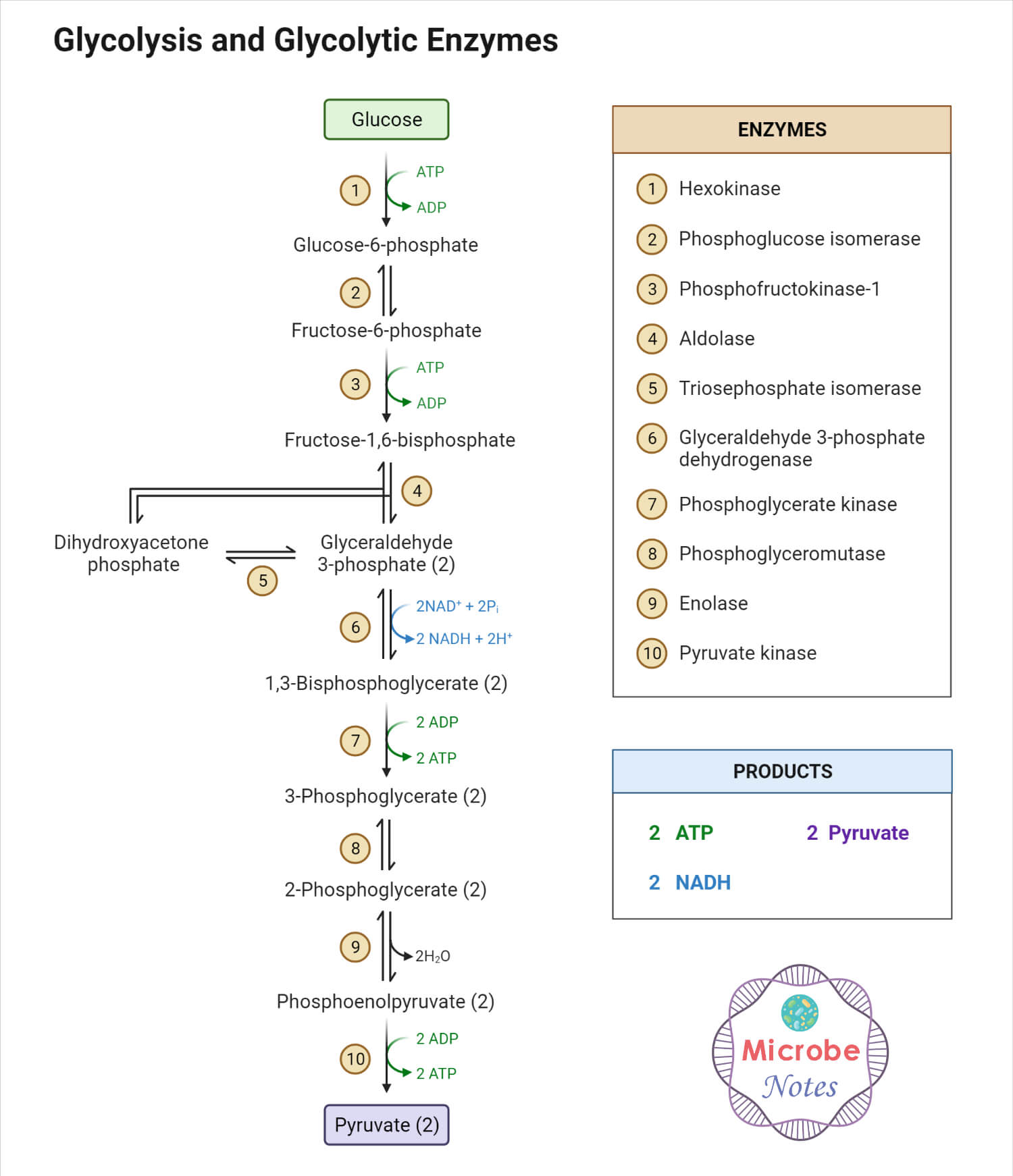Aerobic respiration refers to the concept of the breakdown of nutrients and the production of energy. Any organism, when consuming any nutritive material, the material goes through a series of biochemical reactions by which simple form of carbohydrates, proteins, and lipids are produced. After that, these produced compounds are further degraded and produces the energy required for the organism. Glycolysis refers to the biochemical pathway by which glucose breaks down into pyruvate and produces energy in the form of ATP. It takes place at the cytoplasmic matrix of any prokaryotic or eukaryotic cell. Glycolysis is also known as Embden – Meyerhof – Parnas pathway (E.M.P.) as the pathway was first discovered by Gustav Embden, Otto Meyerhof, and Jakub Karol Parnas.

Interesting Science Videos
Overview
The process of glycolysis is divided into two phases. Firstly, the Preparatory phase consists of five different reactions. During this phase, the glucose molecule converted into glyceraldehyde 3 phosphate by moving through different reactions. Two molecules of ATP are invested during this phase while two newly synthesized molecules of ATP are also found at the end of the preparatory phase. Secondly, the Payoff phase where glyceraldehydes 3 phosphate moves through five different biochemical reactions and converted into pyruvate. Production of ATPs as energy molecules is an important aspect of the payoff phase. Each step of the process is now described as following
1. Phosphorylation of Glucose
This is the first step of the preparatory phase where glucose is activated by the involvement of the enzyme called hexokinase and converted into glucose 6 phosphate. An ATP molecule is used during this step as a phosphate donor. Hexokinase requires Mg2+ to catalyze the reaction.
2. Conversion of Glucose 6 Phosphate to Fructose 6 phosphate
Phosphohexose isomerizes (Phosphogulco isomerase) catalyzes the reaction in the presence of Mg2+ which leads to reversible isomerization of glucose 6 phosphates (aldose) to fructose 6 phosphate (ketos). This isomerization plays an important role to complete the overall pathway of glycolysis. The rearrangement of the carbonyl and hydroxyl group at C1 and C2 is a crucial step to carry forward the pathway further.
3. Phosphorylation of Fructose 6 phosphate
This step utilizes ATP as phosphate donor and by the help of the enzyme phosphofructokinase – 1 (PFK-1) enzyme (which catalyzes the reaction), one phosphoryl group is transferred to fructose 6 phosphate and produces fructose 1,6 bis-phosphate. This is an irreversible reaction that occurs at the cellular level and it is also considered as the first committed step towards glycolysis as glucose 6 phosphate and fructose 6 phosphate has other different involvement while fructose 1, 6 bis-phosphate is targeted only for glycolysis.
4. Cleavage of Fructose 1,6 bis-phosphate
Here, fructose 1,6 bisphosphate is cleaved and produces two different triose phosphates such as glyceraldehyde 3 phosphate and dihydroxyacetone phosphate. The aldol condensation reaction is reversible and catalyzed by the enzyme fructose 1,6 bis-phosphate aldolase (commonly known as aldolase).
5. Interconversion of the Triose phosphates
Glyceraldehyde 3 phosphate, produced at the previous step, goes through different biochemical reactions of the pathway. While, dihydroxyacetone phosphate, on the other hand, rapidly and reversibly converted into glyceraldehyde 3 phosphate by the involvement of the enzyme triose phosphate isomerize.
6. Oxidation of Glyceraldehyde 3 phosphate to 1,3, Bisphospho glycerate
This is the first step of the payoff phase. The reaction is catalyzed by the enzyme glyceraldehyde 3 phosphate dehydrogenase. Along with 1,3 bisphosphoglycerate, NADH+ H+ is also produced during this phase. NADH is also an energy molecule.
7. Phosphoryl transfer form 1,3 bisphosphoglycerate to ADP
3 Phosphoglycerate is produced in this step by the involvement of the enzyme phosphoglycerate kinase. The enzyme transfers the high energy phosphoryl group from the carbonyl group of 1,3 bisphosphoglycerate to ADP. It leads to the formation of ATP.
8. Conversion of 3 phosphoglycerates to 2 phosphoglycerate
In this step, the phosphoryl group in 3 phosphoglycerates is shifted to the C-2 position which yields 2 phosphoglycerates. The reaction is catalyzed by the enzyme phosphoglycerate mutase which requires Mg2+ ion for its activity.
9. Dehydration of 2 phosphoglycerates to Phosphoenolpyruvate
Phosphoenol pyruvate is produced by 2 phosphoglycerates due to the release of water molecules. The reaction is catalyzed by the enzyme enolase.
10. Transfer of the phosphoryl group
Pyruvate kinase catalyzes the last reaction of glycolysis where the phosphoryl group is released from phosphoenolpyruvate and joins with ADP and leads to the production of ATP.
Number of ATP
ATP produced from glycolysis = 2 ATP
2 NADPH (3 ATP each in ETC)= 6 ATP in ETC
Reference
David L. Nelson and Michael M. Cox, Lehninger Principles of Biochemistry, 4th Edition.

Thanks so much, it was explicit. And the diagrams are relatable.
I appreciate the work and effort involved in attaining the knowledge in various course units